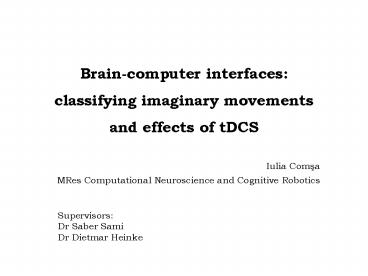Brain-computer interfaces: classifying imaginary movements and effects of tDCS
1 / 23
Title:
Brain-computer interfaces: classifying imaginary movements and effects of tDCS
Description:
Brain-computer interfaces: classifying imaginary movements and effects of tDCS Iulia Com a MRes Computational Neuroscience and Cognitive Robotics –
Number of Views:248
Avg rating:3.0/5.0
Title: Brain-computer interfaces: classifying imaginary movements and effects of tDCS
1
Brain-computer interfaces classifying imaginary
movements and effects of tDCS
- Iulia Comsa
- MRes Computational Neuroscience and Cognitive
Robotics
Supervisors Dr Saber Sami Dr Dietmar Heinke
2
Presentation structure
- An overview of brain-computer interfaces
- Experiment 1 effects of tDCS on the EEG
- Implementing a brain-computer interface with
robotic feedback - Experiment 2 imagined movements (pilot study)
3
Brain-computer interfaces (BCIs)
- What is a BCI?
- A communication system that does not depend on
the brains normal output pathways of peripheral
nerves and muscles (Wolpaw et al., 2000) - In this project BCIs based on motor imagery
4
The structure of a BCI
- Wolpaw et al. (2002)
5
Brain imaging techniques for BCIs
- Electroencephalography (EEG)
- Records electric potentials from the scalp
- Advantages
- Very good temporal resolution
- Comfortable and cost-efficient
- Already on the market for home entertainment
http//www.biosemi.com/
6
Brain imaging techniques for BCIs
- Transcranial direct current stimulation (tDCS)
- Direct current applied to the brain
- Induces changes in cortical excitability
- Anodal increases excitability
- Cathodal decreases excitability
http//www.neuroconn.de
7
Brain imaging techniques for BCIs
- Transcranial direct current stimulation (tDCS)
- Influences TMS-induced motor evoked
- responses in real or imagined movements
- (Lang et al. 2004, Quartarone et al. 2004)
- Potential benefit for classification
- No study in literature about its effect on the
EEG in the motor area
http//www.neuroconn.de
8
Investigating the effects of tDCS
- Question Does tDCS produce significant changes
in event-related potentials in the motor area?
- Event-related potential (ERP) brief change in
electric potential that follows a motor, sensory
or cognitive event
Luck et al. (2007)
9
Investigating the effects of tDCS
- Previously collected data available
- Three groups of participants (9 participants
each) - Anodal tDCS
- Cathodal tDCS
- Sham
- Task
- 250 real finger taps
- 250 imaginary finger taps
- Two sessions before and after tDCS
- Data collection
- 128 EEG channels using a Biosemi ActiveTwo system
10
Investigating the effects of tDCS
- Data pre-processing (EEGLAB Toolbox)
- Filtering
- Between 1 and 100 Hz
- Epochs (segments of data) were extracted between
0 and 1 second following the stimulus - Artefact rejection
- Removing data contaminated by noise (e.g. blinks)
- By amplitude threshold (55-125 mV) and manually
11
Investigating the effects of tDCS
- ERP grand averages (ERPLAB Toolbox)
Anode
Sham
Cathode
Real taps
Imagined taps
12
Investigating the effects of tDCS
- Permutation t-tests (Mass Univariate ERP Toolbox)
- Family-wise alpha level 0.05
- 2500 permutations
- Tmax statistic
- (Blair Karniski, 1993)
Anode-Cathode t-scores, real finger taps after
tDCS video
13
Investigating the effects of tDCS
- Significant differences for real taps
Anode-Cathode
Anode-Sham
Cathode-Sham
85 ms
230 ms
14
Investigating the effects of tDCS
- Differences for imagined taps
Anode-Cathode
Anode-Sham
Cathode-Sham
80 ms
700 ms
15
Effects of tDCS on ERPs Summary
- Significant effects found for anodal tDCS in the
motor area around 85 and 230 ms during real
movements - Significant effects found for cathodal tDCS
around 700 ms in the parietal area during
imaginary movements - Although not always significant, differences in
the motor area are visible in all conditions
16
Oscillatory EEG processes
- ERPs phase-locked activity
- What if the response is not phase-locked?
- Induced responses EEG frequency bands
- Mu rhythms 8-13 Hz
- Recorded from the sensorimotor cortex while it is
idle - Briefly suppressed when an action is performed or
imagined - Beta rhythms 13-30 Hz
- Gamma rhythms 30-40 Hz, 60-90 Hz
17
Building a BCI with robotic feedback
BCI2000 a general-purpose system for BCI research
consisting of configurable modules
Stimulus Presentation
Signal Acquisition
Signal Processing
- BCILAB Toolbox - provides
- Signal preprocessing (filtering, cleaning)
- Feature extraction Common Spatial Patterns
- Machine learning algorithms for classification
- RWTH Aachen MINDSTORMS NXT Toolbox
- Robot arm control
18
Imagined movements pilot study
- 3 healthy participants
- Imagined left and right hand clenching
- (100 trials each)
- Data collection 32 electrodes
- covering the motor-premotor area
- (using a Biosemi ActiveTwo system)
19
Imagined movements pilot study
- r2 (coefficient of determination) the amount of
variance that is accounted for by the task
condition - Strongest activity 10-30 Hz in lateral
electrodes - Some activity above 60 Hz
Channel
Frequency (1-70 Hz)
20
Imagined movements pilot study
- Best results 10 fold cross-validation
- Epochs between 1 and 2 seconds after stimulus
- Classifier linear discriminant analysis
- Participant 2 88,5 accuracy
- Common Spatial Patterns
- FIR Filter 10-30 Hz bandpass
- Participant 3 85,5 accuracy
- Filter-Bank Common Spatial Patterns
- Frequency windows 8-30 Hz and 8-15 Hz
- No model with accuracy better than 65 could be
trained for Participant 1
21
Further work Improving the results
- More trials
- Problem subjects may get bored
- Adding online feedback
- Problem we would already need a good classifier
- Incorporating purpose in the motor imagery
- Clenching a fist versus grabbing a pen
- Using tDCS
- 99 accuracy for the tDCS data from Experiment 1
22
Project summary
- We showed that tDCS has significant effects on
event-related potentials - We implemented a brain-computer interface with
robotic feedback - We performed a pilot study and explored
classification of left and right imaginary
movements
23
Thank you.































